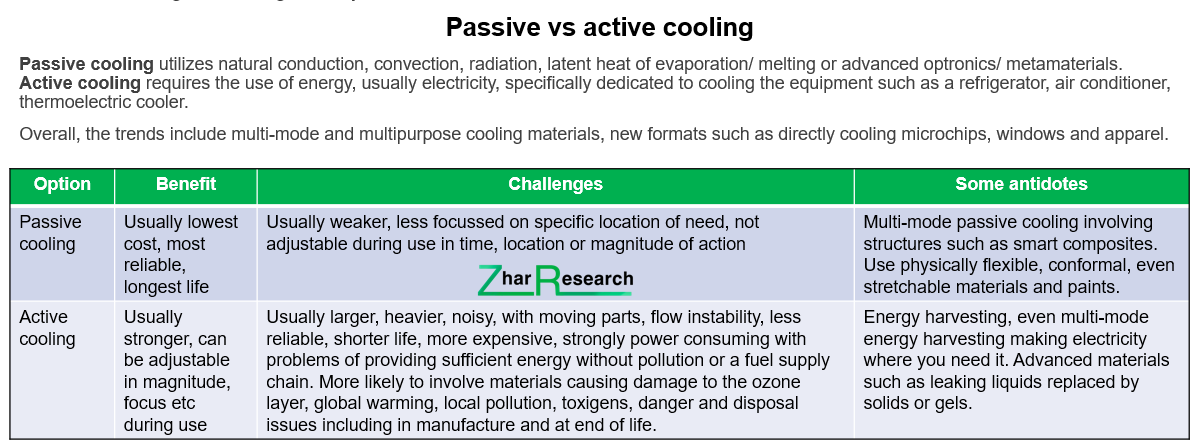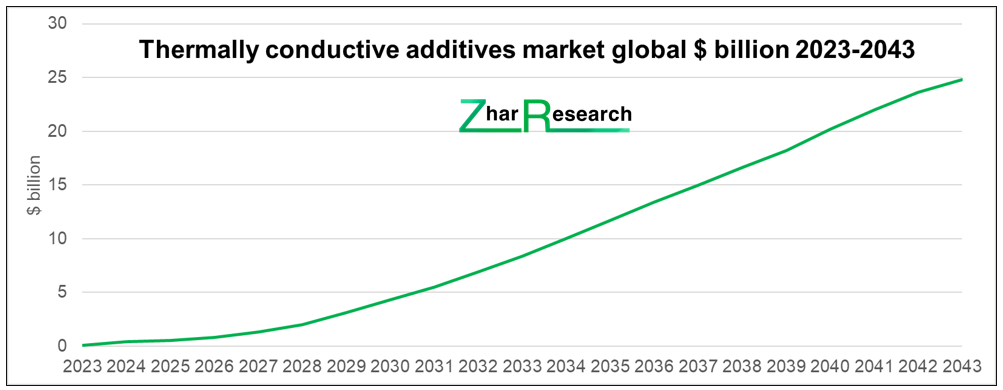Startups Leading the New Cooling Industry
On the other hand, Incooling BV has been founded to, “cool the planet one server at a time”.
The emerging trillion-dollar cooling hardware market is fully analysed in two new reports from Zhar Research. “Passive Cooling Materials and Devices: New Markets 2023-2043” covers the ones needing no power. “Active Cooling: Large New Materials, Systems Markets 2023-2043” covers those needing power input but usually providing stronger cooling in return. That is a world of vapor compression and pumped liquid pipework chased by an increasing choice of entirely solid alternatives. It all tackles threats from global warming but also hotter data centers, electric vehicles land, water and air and much more. Expect cooling apparel, self-cooling microchips, windows that cool and other exotica. A tsunami of research is chasing this burgeoning demand. But also watch the small companies surging ahead.
Dr Peter Harrop, CEO of Zhar Research notes,
“Small and medium enterprises often show the way with rapidly emerging technologies and this is no exception. Consider them as partners or acquisitions, buying you valuable time, talent and intellectual property. For example, apparel that cools could be a lifesaver as places like India which increasingly suffers 50°C excursions. Startup HEIQ has the world’s first textile technology to deliver both instant contact cooling and continuous evaporative cooling for optimal well-being day and night. It cools before the first sign of sweat, delays the build-up of heat and continuously regulates the temperature. Instantly cool to the touch, the components synergistically recharge the surface layer ensuring a consistently cool, dry and comfortable climate around the body. However, some passively cooled apparel is weak particularly in high humidity so another startup Oceanit has created a highly effective battery-powered cooling vest using its proprietary, Thermocore® tubing. Its thermal conductivity matches that of the human body, facilitating heat transfer between your body and the coolant. This year US Military contracted Oceanit to make its next generation of war-fighter apparel that cools. Zhar Research has identified many other very significant small companies to watch. They have some of the best technologies to address the very different cooling needs that are arriving.”
Reducing the impact of vapor-compression aircon
Air conditioning and refrigeration systems consume close to 25% of electricity generated worldwide and are responsible for 7% of global greenhouse gas emissions yet almost all continue to use good old vapor compression cooling that improves little over the years. Start-up SkyCool Systems is the first company to employ radiative sky cooling with air conditioning and refrigeration systems. It applies a dual-mode film to the top surface of each panel. The film reflects sunlight to prevent the panels from heating up during the day and also emits infrared heat to the cold sky, which keeps the panels and any fluid flowing in them cool all the time. The fluid to be cooled is pumped through each panel. The panel temperature can drop by up to 8°C below the ambient temperature with zero electricity input. Nokia spinoff Accelsius has new passive technology, in this case targetted for cooling future data centers so they can perform better yet fit into city sites. More speculatively, startup Transaera sees its metal organic frameworks dehumidifying the air to supplement vapor compression cooling because pulling moisture out of the air takes up about half of the electricity used by traditional air conditioners.
Electric vehicles and more
Electric vehicles by land, water and air are rapidly gaining market share but with their range of travel a concern. The vehicle climate control can waste electricity reducing range so reducing its power consumption by ultra-lightweight aerogel insulation is addressed by one startup, starting with possible use in electric aircraft, where weight is particularly critical. Calyos, incorporated in 2014 to provide advanced heat pipes (passive evaporative closed systems for cooling) targets the electric vehicle and computing sectors. On the other hand, Israeli start-up SolCold has developed an environmentally friendly anti-Stokes material that helps to cool the temperature in a vehicle or other location. The first clients are expected to come from the business world paying around three dollars per square meter for it. Its cooling effect works both during the summer and winter and more strongly in low humidity, so it may be particularly useful in the Middle East and deserts. The phenomenon is a special optical process which converts long-wavelength excitation to short-wavelength emission – the opposite of a greenhouse. Practical versions juggle reflection, conduction and radiation. They appear as both active and passive cooling structures.
Microchips to delayed grid electricity
With one kilowatt microchips on the way, their cooling by new methods comes center stage. First revealed at CES 2023, AirJet® by $18M company Frore Systems is the world’s first solid-state chip for active device cooling. It silently delivers 2x improvement in device performance. Its compact size and unique capability enable faster, quieter, thinner, lighter, dustproof devices. Notebooks can now run twice as fast, they claim. On the other hand, Incooling BV has been founded to, “cool the planet one server at a time”. It puts nanotubes through the chip substrate, pumping pressurised liquid carbon dioxide coolant through them. That liquid carbon dioxide appears on the grand scale too. Startup Energy Dome develops giant liquid carbon dioxide facilities for delayed electricity on the grid. In that world, young company Highview Power leads in liquid air cooling for delayed electricity. Both are so-called Long Duration Energy Storage, a rapidly growing sector driven by wind and solar power being lowest cost yet intermittent. See Zhar Research report, “Long Duration Energy Storage LDES Markets 2023-2043: Grid Microgrid Delayed Electricity 6 Hours to Seasonal” which also includes coverage of the bursting orderbook for compressed air options needing cooling on the grand scale served by youngster Hydrostor.
Coatings and coverings
Much of the next generation cooling technologies involve panels, layers, coatings and even paint. We have discussed some already. In addition, small R&D company Plasmonics uses its design and fine lithography expertise to develop thermal metamaterial coatings. Startup Inventwood has a lightweight, waterproof panel exhibiting the phenomenon of Passive Daylight Radiative Cooling PDRC. Ruggedised and translucent, it has the potential to be a structural material enabling cooler buildings. Indeed, it has been demonstrated cooling fluids in air conditioning systems on the roof of a building – a neat combination of active and passive cooling. The new Zhar Research reports have the detail with independent forecasts and roadmaps. Read “Passive Cooling Materials and Devices: New Markets 2023-2043” and “Active Cooling: Large New Materials, Systems Markets 2023-2043”.
Press release distributed by Pressat on behalf of Zhar Research , on Tuesday 9 May, 2023. For more information subscribe and follow https://pressat.co.uk/
Passive Cooling Active Cooling Ldes Cooling Energy Environment Hardware Materials Emerging Markets Future Liquid Air Vehicles Microchips Business & Finance Consumer Technology Education & Human Resources Environment & Nature Manufacturing, Engineering & Energy
Published By

anastasiams@zharresearch.com
https://www.zharresearch.com/
Dr Peter Harrop
peterharrop@zharresearch.com
Visit Newsroom
You just read:
Startups Leading the New Cooling Industry
News from this source:



